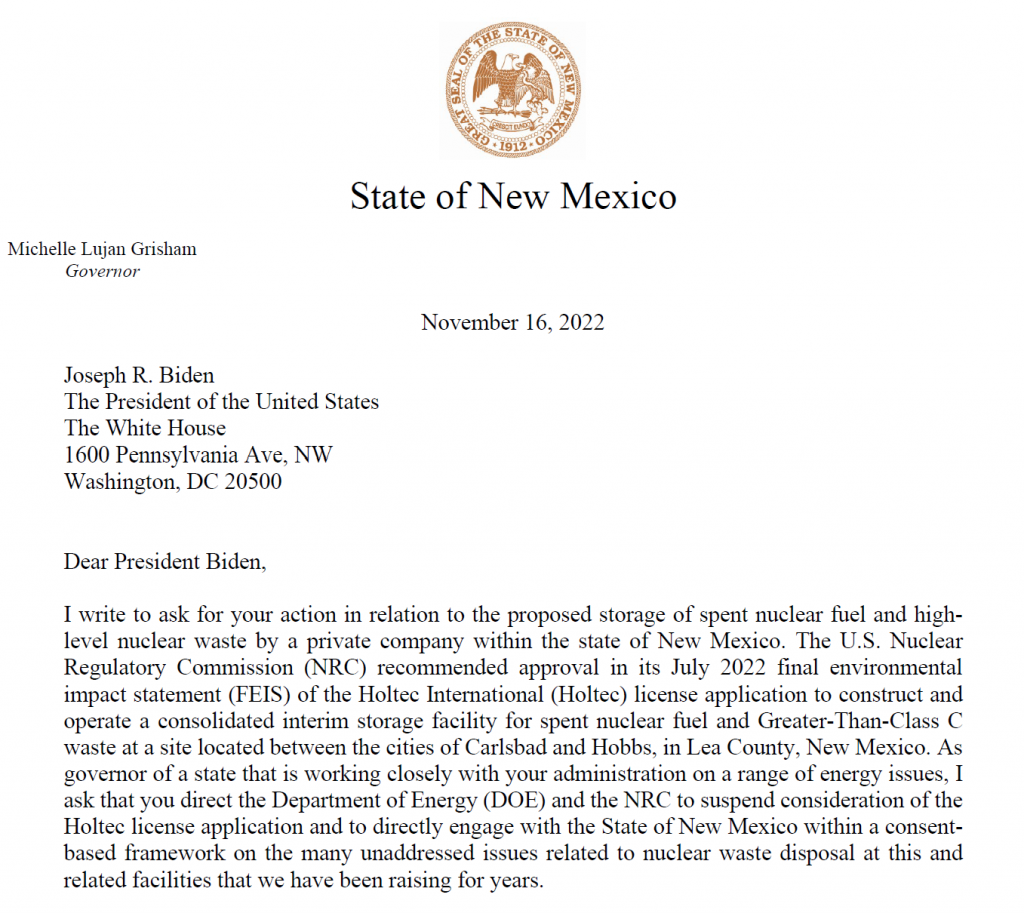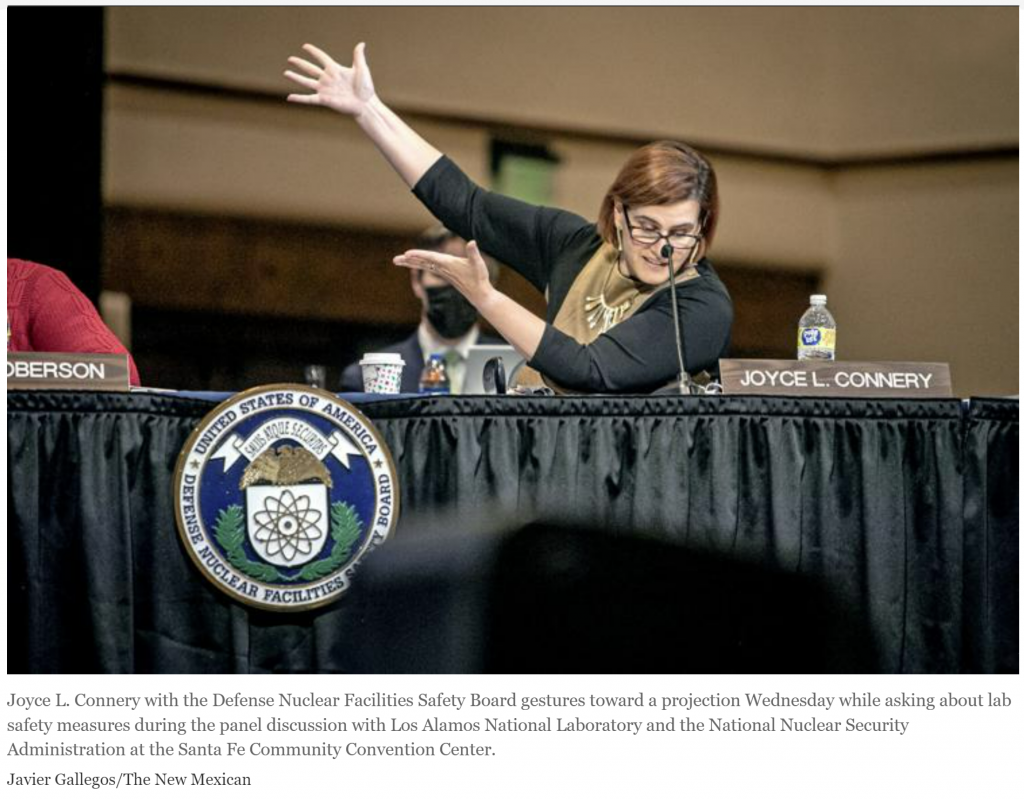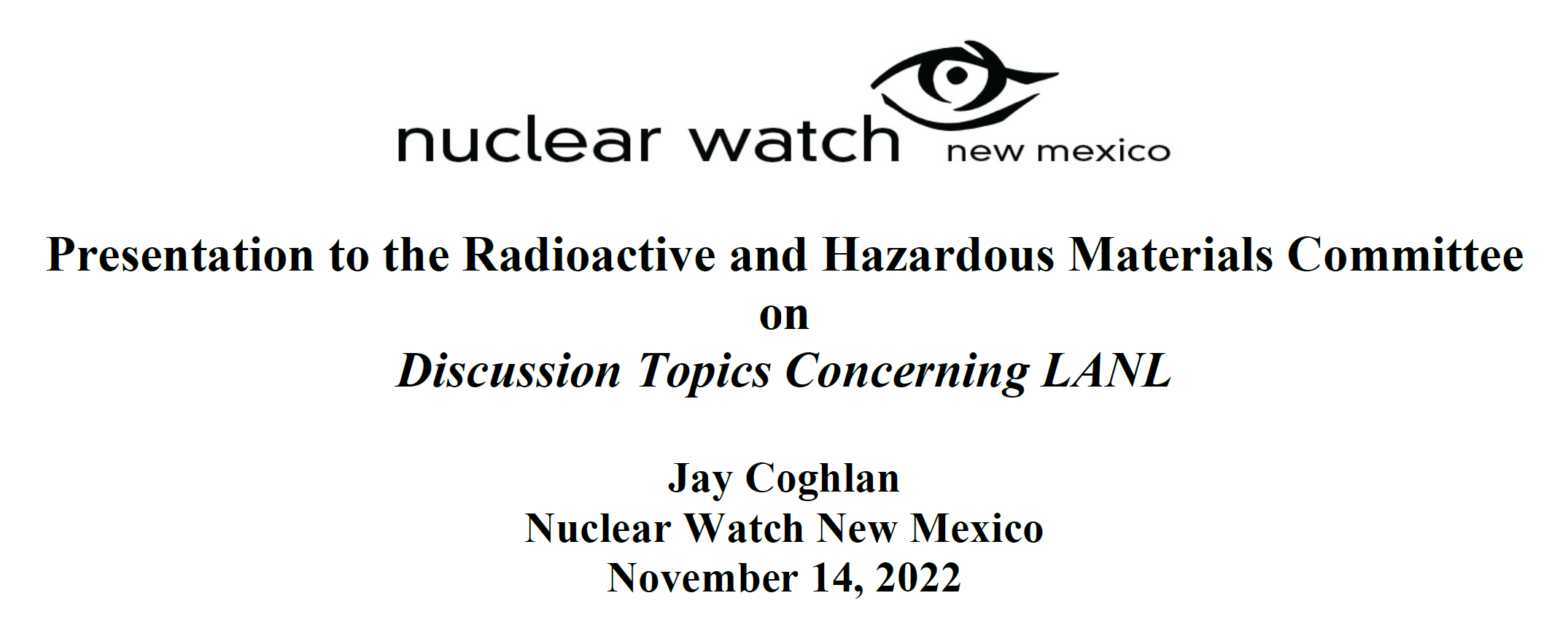QUOTE OF THE WEEK
Nothing Found
It seems we can’t find what you’re looking for. Perhaps searching can help.
LANL’s Central Mission: Los Alamos Lab officials have recently claimed that LANL has moved away from primarily nuclear weapons to “national security”, but what truly remains as the Labs central mission? Here’s the answer from one of its own documents:
LANL’s “Central Mission”- Presented at: RPI Nuclear Data 2011 Symposium for Criticality Safety and Reactor Applications (PDF) 4/27/11
Banner displaying “Nuclear Weapons Are Now Illegal” at the entrance in front of the Los Alamos National Lab to celebrate the Entry Into Force of the Nuclear Weapon Ban Treaty on January 22, 2021
Nothing Found
It seems we can’t find what you’re looking for. Perhaps searching can help.
Follow the Money!
Map of “Nuclear New Mexico”
In 1985, US President Ronald Reagan and Russian President Mikhail Gorbachev declared that “a nuclear war cannot be won and must never be fought.”

Waste Lands: America’s Forgotten Nuclear Legacy
The Wall St. Journal has compiled a searchable database of contaminated sites across the US. (view)
Related WSJ report: https://www.wsj.com
NEW & UPDATED
Nuclear watchdog accuses ex-environment official of conflicting interests after she accepts LANL job
“Jay Coghlan, executive director of Nuclear Watch New Mexico, said there’s a long list of Environment Department officials who went to work for the lab or the agencies that manage it.
He noted Chris Catechis, acting director of the state Resources Protection Division, is going to work for the lab just weeks after Stringer took a job with the nuclear security agency.”
BY SCOTT WYLAND, THE SANTA FE NEW MEXICAN | November 28, 2022 santafenewmexican.com
A nuclear watchdog group wants a state commission to nullify its decision on a permit for Los Alamos National Laboratory’s radioactive liquid waste treatment facility, arguing the panel’s former chairwoman backed a ruling favorable to the lab while she sought a job with the federal agency that oversees it.
Strong earthquake rattles remote West Texas desert
Many of these shelters, which are marked by a characteristic yellow sign, were not specifically designed for such purposes and may not have provided sufficient levels of protection against radiation
BY ASSOCIATED PRESS TEXAS | November 16, 2022 spectrumlocalnews.com
MENTONE, Texas (AP) — A strong earthquake shook a sparsely populated patch of desert in West Texas on Thursday, causing tremors felt as far away as the Mexican city of Ciudad Juárez. The magnitude 5.3 earthquake struck around 3:30 p.m., according to Jim DeBerry, a meteorologist with the National Weather Service in the West Texas city Midland. He said the strength of the quake means it likely caused damage in the remote oil patch and scrubland, but none had been reported so far.
DeBerry said the epicenter was about 23 miles (37 kilometers) south of Mentone, a tiny community south of the New Mexico state line and 95 miles (153 kilometers) west of Midland.
State Rep. Eddie Morales, Jr., whose district includes Mentone, said he spoke with local authorities and there were no reported injuries. He said via Twitter that state officials will be “inspecting roads, bridges and other infrastructure as a precaution.”
DeBerry said there were reports of people feeling vibrations from the quake 200 miles (515 kilometers) west in the border city of Ciudad Juárez and as far south as Terlingua, a small community near the Rio Grande and Big Bend National Park.
Russia-US nuclear disarmament talks postponed
Officials from the two countries were due to meet in the Egyptian capital of Cairo from November 29 to December 6.
ALJAZEERA | November 28, 2022 aljazeera.com
Nuclear disarmament talks between Russia and the United States set to take place this week have been postponed, according to Moscow’s foreign ministry and the US Embassy.
Officials from the two countries were due to meet in the Egyptian capital of Cairo from November 29 to December 6 to discuss resuming inspections under the New START nuclear arms reduction treaty, which had been suspended in March 2020 due to the COVID-19 pandemic.
After decades as a nuclear powerhouse, France makes its play in offshore wind
EDF says the 480-megawatt Saint-Nazaire Offshore Wind Farm would help to “support the French State’s energy transition goals.”
By Anmar Frangoul | November 25, 2022 cnbc.com
A facility described as “France’s first commercial-scale offshore wind project” is fully operational, multinational utility EDF said this week.
The news represents a significant step forward for the country’s offshore wind sector, with more projects set to come online in the years ahead.
In a statement Wednesday, EDF said the 480-megawatt Saint-Nazaire Offshore Wind Farm would help to “support the French State’s energy transition goals, which include targets to generate 32% of its energy from renewable sources by 2030.” EDF’s majority shareholder is the French state.
Gov. Lujan Grisham demands President Biden block nuclear waste site in southeast New Mexico
Nuclear waste storage in southeast New Mexico drew the ire of Gov. Michelle Lujan Grisham, who called on President Joe Biden via a Wednesday letter to block such a project near Carlsbad and Hobbs for perceived threats to nearby residents and implications of environmental racism.
“New Mexico has grave concerns for the risk this proposed storage site would pose to our citizens and communities, our first responders, our environment, and to New Mexico’s agriculture and natural resource industries,” Lujan Grisham wrote.
CALRSBAD CURRENT ARGUS | By Adrian Hedden, Carlsbad Current-Argus | November 18, 2022 currentargus.com
 Holtec International proposed the project, which would store up to 100,000 metric tons of spent nuclear fuel rods on the surface in a remote area near the Eddy-Lea county line, after being recruited by a consortium of local leaders in the area known as the Eddy-Lea Energy Alliance.
Holtec International proposed the project, which would store up to 100,000 metric tons of spent nuclear fuel rods on the surface in a remote area near the Eddy-Lea county line, after being recruited by a consortium of local leaders in the area known as the Eddy-Lea Energy Alliance.
The Alliance provided the land, about 1,000 acres amid the oilfields of the Permian Basin, and worked with Holtec to promote the project and seek public support.
But Lujan Grisham, her administration and elected officials both at the state government and in Congress became opposed to the project, frequently voicing their disapproval in the years since.
Russia’s invasion of Ukraine could start a race for nukes, Austin says
The Defense secretary painted a bleak picture for the world, alluding to a scenario in which autocrats will race to acquire the bomb if Russia isn’t repelled.
“Austin further warned that “Putin may resort again to profoundly irresponsible nuclear saber-rattling” as the war drags on and if Ukrainian forces continue their gains against Russian troops.”
POLITICO | By PAUL MCLEARY & ALEXANDER WARD, November 19, 2022 politico.com
HALIFAX, Nova Scotia — Russia’s invasion of Ukraine could entice autocrats around the world to race to develop nuclear weapons, Defense Secretary Lloyd Austin said Saturday, potentially sparking a dangerous era of nuclear proliferation.
Moscow has threatened to use tactical nuclear weapons against Ukraine several times over the past nine months, leading to a flurry of phone calls this month between U.S., European and Russian officials trying to tamp down tensions.
A day before he leaves for a multi-day swing through the Indo-Pacific, Austin painted a bleak picture for the world, alluding to a scenario in which autocrats will race to acquire the bomb if Putin isn’t successfully repelled.
Watchdog agency grills LANL, nuclear officials on lab safety
[NukeWatch would amend this headline to add “‘lightly’ grills” – The DNFSB was asking tough questions, but DOE and the LANL contractors were not forthcoming with those answers.]
“Much of the discussion involved complex, technical subjects. But board Chairwoman Joyce Connery said a basic complaint is the lack of response the board has gotten at times when raising concerns in letters sent to the lab and nuclear security agency.”
THE SANTA FE NEW MEXICAN | By Scott Wyland, November 16, 2022 santafenewmexican.com

A federal watchdog agency on Wednesday grilled top officials from Los Alamos National Laboratory and the agency that oversees nuclear weapons about ongoing safety concerns and how they aim to resolve them as the lab gears up to produce an unprecedented number of warhead triggers.
The Defense Nuclear Facilities Safety Board, an independent organization within the executive branch, questioned lab Director Thom Mason and National Nuclear Security Administration head Jill Hruby about safety issues that could prove important as the lab moves toward making 30 bomb cores, known as pits, per year by 2026.
The board provides recommendations and advice to the president and the secretary of energy regarding public health and safety issues at Department of Energy defense nuclear facilities.
The daylong hearing was held at the Santa Fe Community Convention Center. It is the first time in several years the safety board has held a public hearing in the Santa Fe area.
Continue reading
A Clear Case of Disqualification of NMED Deputy Cabinet Secretary Stephanie Stringer – Concerned Citizens For Nuclear Safety
The National Nuclear Security Administration (NNSA) has provided evidence to CCNS and Honor Our Pueblo Existence (HOPE) that Stephanie Stringer, a New Mexico Environment Department Deputy Cabinet Secretary and Chair of the New Mexico Water Quality Commission, made adjudicatory decisions against the non-governmental organizations while she was applying for NNSA employment.
CONCERNED CITIZENS FOR NUCLEAR SAFETY | November 17, 2022 nuclearactive.com
![]() This is the second time NNSA has hired an adjudicatory decision-maker during an ongoing proceeding addressing the groundwater discharge permit, DP-1132, for the Radioactive Liquid Waste Treatment Facility at Los Alamos National Laboratory. http://nuclearactive.org/wp-content/uploads/2019/06/190606-CCW-Petition-for-Mandamus-2019-06-06.pdf , see ¶¶ 14 – 24.
This is the second time NNSA has hired an adjudicatory decision-maker during an ongoing proceeding addressing the groundwater discharge permit, DP-1132, for the Radioactive Liquid Waste Treatment Facility at Los Alamos National Laboratory. http://nuclearactive.org/wp-content/uploads/2019/06/190606-CCW-Petition-for-Mandamus-2019-06-06.pdf , see ¶¶ 14 – 24.
This time, Stephanie Stringer, after applying for the NNSA job, demonstrated her bias by not recusing herself from the matter. She voted against the NGOs in the requested permit review before the Water Quality Control Commission.
New study reveals ‘shocking’ number of deaths in southern Ohio county
“PORTS is a massive complex that dominates the landscape in Pike County and, for people in the communities that surround it, so do cancer and death.”
OHIO, LOCAL12 NEWS | By DUANE POHLMAN, WKRC | November 16, 2022 local12.com
ANOTHER SOMBER MOMENT IN THE CEMETERY
PIKE COUNTY, Ohio (WKRC) – On a crisp, sun-drenched day, the shadow of sadness followed Larry Farmer as he made a now-routine somber walk at Mound Cemetery in Piketon, Ohio.
Larry comes there three-to-four times a month to visit his son.
“I come in here and talk to Zach,” Larry said, at a spot overlooking a tombstone with etched pictures of his son smiling in his baseball uniform.
AN ALL-AMERICAN STORY
Zach Farmer was an All-American baseball pitcher at Piketon High School and rising start at Ohio State, when his dreams of making it to the big leagues were cut down by acute myeloid leukemia.
He died in 2015, just eight days after he turned 21.
“You’re never going to find peace,” Larry said as he recalled the pain of losing his son.
Watch: DNFSB Hearing on “Legacy cleanup activities, nuclear safety, and increased production activities” at Los Alamos National Laboratory (LANL)
The New Mexico Missile that nearly bombed Albuquerque
Questionable Department of Energy benefits to New Mexico:
• DOE plans to spend $9.4 billion in New Mexico during this fiscal year 2023, 71% for nuclear weapons research and production while much of the rest is for related radioactive waste disposal. This is 10% more than the State’s entire operating budget of $8.5 billion. Forty-one percent of the National Nuclear Security Administration’s nation-wide FY 2023 nuclear weapons research and production budget will be spent in the Land of Enchantment alone(1).
• How does this really benefit New Mexicans when the Land of Enchantment:
- Has the third highest rate of poverty (18.2%) after Mississippi and Louisiana(2);
- Is fourth lowest in per capita income in 2022, 3 down from 37th in 1959; and
- Is ranked 46th in best states to live in, according to five criteria (affordability, economy, education and health, quality of life, and safety),4 dead last in quality of education(5) and dead last in quality of life for children?(6)
• At the same time, Los Alamos County is the 11th richest county in the USA(7), has the most millionaires per capita (11.6%)(8), and has been ranked the best county to live in(9). Clearly the economic benefits are for a privileged minority of the New Mexican population.
CRITICAL EVENTS
Nothing Found
It seems we can’t find what you’re looking for. Perhaps searching can help.
ACTION ALERTS
Nothing Found
It seems we can’t find what you’re looking for. Perhaps searching can help.
Nothing Found
It seems we can’t find what you’re looking for. Perhaps searching can help.
New Nuclear Media: Art, Films, Books & More
Nothing Found
It seems we can’t find what you’re looking for. Perhaps searching can help.
Nothing Found
It seems we can’t find what you’re looking for. Perhaps searching can help.


















